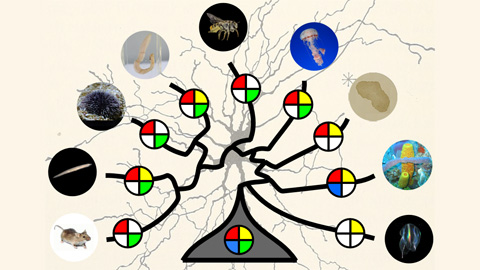New types of glutamate receptors identified

28/11/2018
Researchers of the Molecular Physiology Group of the Synapse of the Sant Pau Biomedical Research Institute (IIB Sant Pau), the Autonomous University of Barcelona (UAB), the University of Barcelona and the French National Center for Scientific Research (CNRS) has published an article in one of the most prestigious scientific journals in the field of Biology and Biomedicine, Elife. This article demonstrates that the two families of neurotransmitter glutamate receptors, essential for the transfer of the nervous impulse between neurons, present an organization much more complex than previously thought and proves that the valid classification, accepted by the scientific community for more 20 years old, is insufficient and is dominated by an overly anthropocentric vision of evolution.
The research team, led by Dr. Àlex Bayés of the IIB Sant Pau, carried out a very thorough study on the evolutionary history of the two families of neurotransmitter glutamate receptors. These proteins are one of the fundamental pillars of the nervous system, since they allow the formation and modulate the power of the nerve impulses.
This study shows that the classification of these two families is incomplete, especially as regards the receptors that form ionic channels. The family of ionotropic receptors (i.e., which form ionic channels) of glutamate has 4 subfamilies never described previously and that instead of being organized in the 6 recognized classes at present there would be 10. The article also demonstrates that the family of metabotropic receptors (they do not form channels but they modulate the function of the ionotropic ones) presents 4 main classes instead of the 3 that was thought
The evolution of these families does not present a linear behavior, of more or less complexity, parallel to the appearance of more elaborate nervous systems. But different lines of the animal kingdom make their evolutionary path independently. Throughout the nearly billion years of evolution of animals, the diversity of glutamate receptors appear to be much higher than those seen in vertebrate genomes.
Previous work has focused on vertebrates, which appear about 400 million years ago, and therefore could not identify all kinds of receptors that exist beyond these species. The study of representative species of all the animal kingdom lineages has allowed to significantly expand the classification of these families. This work represents, therefore, a fundamental change in how we understand the diversity that exists within these receptor families.
The study of the properties of these new receptors could result in the identification of receptors with new properties that could have applications in the field of neurosciences.
It is interesting to think what would happen if similar studies were done in other protein families that have been studied mainly in vertebrates that are, on the other hand, the vast majority.
Reference: David Ramos-Vicente, Jie Ji, Esther Gratacòs-Batlle, Gemma Gou, Rita Reig-Viader, Javier Luís, Demian Burguera, Enrique Navas-Perez, Jordi García-Fernández, Pablo Fuentes-Prior, Hector Escriva, Nerea Roher, David Soto, Àlex Bayés. Metazoan evolution of glutamate receptors reveals unreported phylogenetic groups and divergent lineage-specific events. eLife 2018;7:e35774 doi: 10.7554/eLife.35774